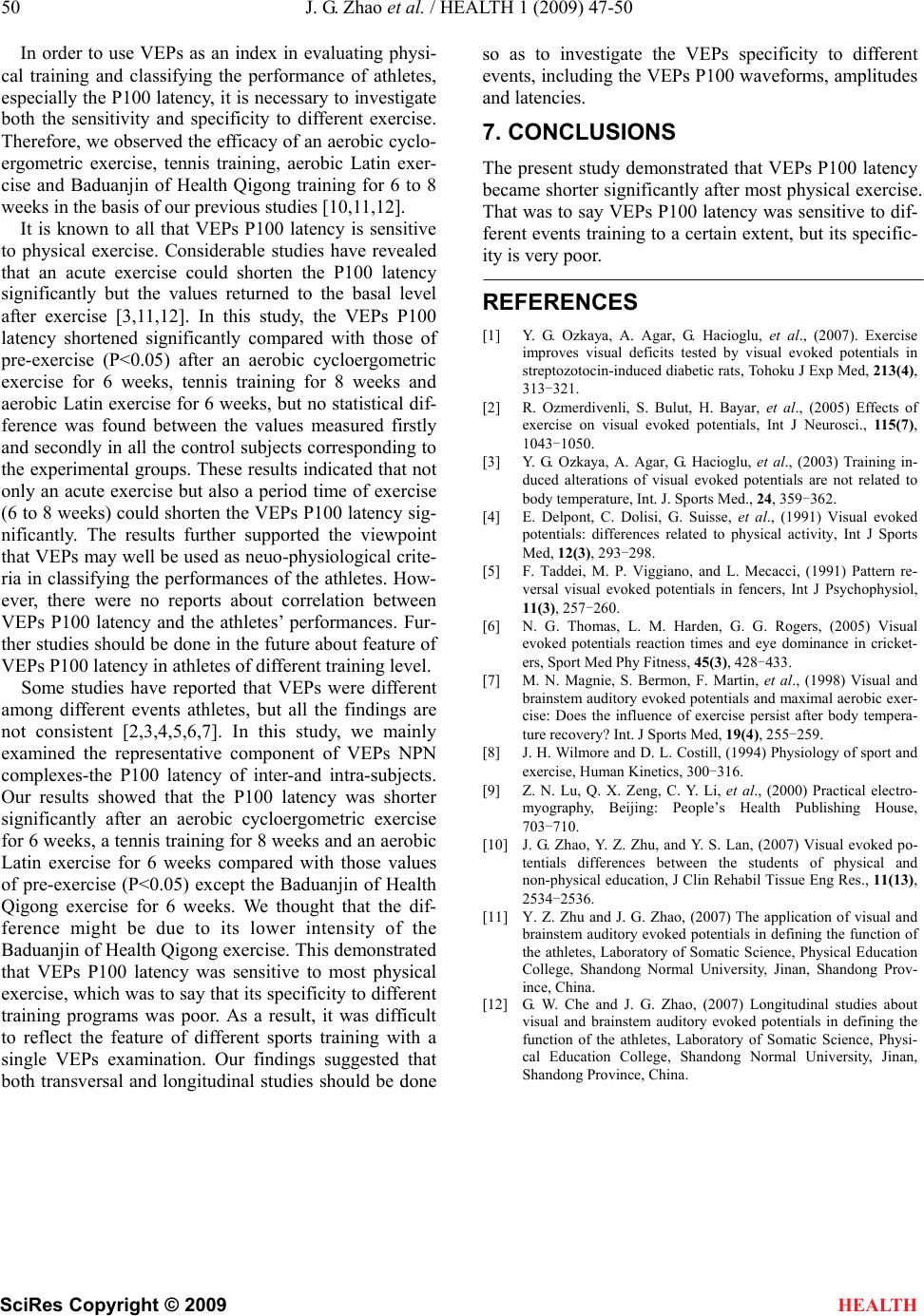
50 J. G. Zhao et al. / HEALTH 1 (2009) 47-50
SciRes Copyright © 2009 HEALTH
In order to use VEPs as an index in evaluating physi-
cal training and classifying the performance of athletes,
especially the P100 latency, it is necessary to investigate
both the sensitivity and specificity to different exercise.
Therefore, we observed the efficacy of an aerobic cyclo-
ergometric exercise, tennis training, aerobic Latin exer-
cise and Baduanjin of Health Qigong training for 6 to 8
weeks in the basis of our previous studies [10,11,12].
It is known to all that VEPs P100 latency is sensitive
to physical exercise. Considerable studies have revealed
that an acute exercise could shorten the P100 latency
significantly but the values returned to the basal level
after exercise [3,11,12]. In this study, the VEPs P100
latency shortened significantly compared with those of
pre-exercise (P<0.05) after an aerobic cycloergometric
exercise for 6 weeks, tennis training for 8 weeks and
aerobic Latin exercise for 6 weeks, but no statistical dif-
ference was found between the values measured firstly
and secondly in all the control subjects corresponding to
the experimental groups. These results indicated that not
only an acute exercise but also a period time of exercise
(6 to 8 weeks) could shorten the VEPs P100 latency sig-
nificantly. The results further supported the viewpoint
that VEPs may well be used as neuo-physiological crite-
ria in classifying the performances of the athletes. How-
ever, there were no reports about correlation between
VEPs P100 latency and the athletes’ performances. Fur-
ther studies should be done in the future about feature of
VEPs P100 latency in athletes of different training level.
Some studies have reported that VEPs were different
among different events athletes, but all the findings are
not consistent [2,3,4,5,6,7]. In this study, we mainly
examined the representative component of VEPs NPN
complexes-the P100 latency of inter-and intra-subjects.
Our results showed that the P100 latency was shorter
significantly after an aerobic cycloergometric exercise
for 6 weeks, a tennis training for 8 weeks and an aerobic
Latin exercise for 6 weeks compared with those values
of pre-exercise (P<0.05) except the Baduanjin of Health
Qigong exercise for 6 weeks. We thought that the dif-
ference might be due to its lower intensity of the
Baduanjin of Health Qigong exercise. This demonstrated
that VEPs P100 latency was sensitive to most physical
exercise, which was to say that its specificity to different
training programs was poor. As a result, it was difficult
to reflect the feature of different sports training with a
single VEPs examination. Our findings suggested that
both transversal and longitudinal studies should be done
so as to investigate the VEPs specificity to different
events, including the VEPs P100 waveforms, amplitudes
and latencies.
7. CONCLUSIONS
The present study demonstrated that VEPs P100 latency
became shorter significantly after most physical exercise.
That was to say VEPs P100 latency was sensitive to dif-
ferent events training to a certain extent, but its specific-
ity is very poor.
REFERENCES
[1] Y. G. Ozkaya, A. Agar, G. Hacioglu, et al., (2007). Exercise
improves visual deficits tested by visual evoked potentials in
streptozotocin-induced diabetic rats, Tohoku J Exp Med, 213(4),
313-321.
[2] R. Ozmerdivenli, S. Bulut, H. Bayar, et al., (2005) Effects of
exercise on visual evoked potentials, Int J Neurosci., 115(7),
1043-1050.
[3] Y. G. Ozkaya, A. Agar, G. Hacioglu, et al., (2003) Training in-
duced alterations of visual evoked potentials are not related to
body temperature, Int. J. Sports Med., 24, 359-362.
[4] E. Delpont, C. Dolisi, G. Suisse, et al., (1991) Visual evoked
potentials: differences related to physical activity, Int J Sports
Med, 12(3), 293-298.
[5] F. Taddei, M. P. Viggiano, and L. Mecacci, (1991) Pattern re-
versal visual evoked potentials in fencers, Int J Psychophysiol,
11(3), 257-260.
[6] N. G. Thomas, L. M. Harden, G. G. Rogers, (2005) Visual
evoked potentials reaction times and eye dominance in cricket-
ers, Sport Med Phy Fitness, 45(3), 428-433.
[7] M. N. Magnie, S. Bermon, F. Martin, et al., (1998) Visual and
brainstem auditory evoked potentials and maximal aerobic exer-
cise: Does the influence of exercise persist after body tempera-
ture recovery? Int. J Sports Med, 19(4), 255-259.
[8] J. H. Wilmore and D. L. Costill, (1994) Physiology of sport and
exercise, Human Kinetics, 300-316.
[9] Z. N. Lu, Q. X. Zeng, C. Y. Li, et al., (2000) Practical electro-
myography, Beijing: People’s Health Publishing House,
703-710.
[10] J. G. Zhao, Y. Z. Zhu, and Y. S. Lan, (2007) Visual evoked po-
tentials differences between the students of physical and
non-physical education, J Clin Rehabil Tissue Eng Res., 11(13),
2534-2536.
[11] Y. Z. Zhu and J. G. Zhao, (2007) The application of visual and
brainstem auditory evoked potentials in defining the function of
the athletes, Laboratory of Somatic Science, Physical Education
College, Shandong Normal University, Jinan, Shandong Prov-
ince, China.
[12] G. W. Che and J. G. Zhao, (2007) Longitudinal studies about
visual and brainstem auditory evoked potentials in defining the
function of the athletes, Laboratory of Somatic Science, Physi-
cal Education College, Shandong Normal University, Jinan,
Shandong Province, China.